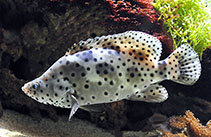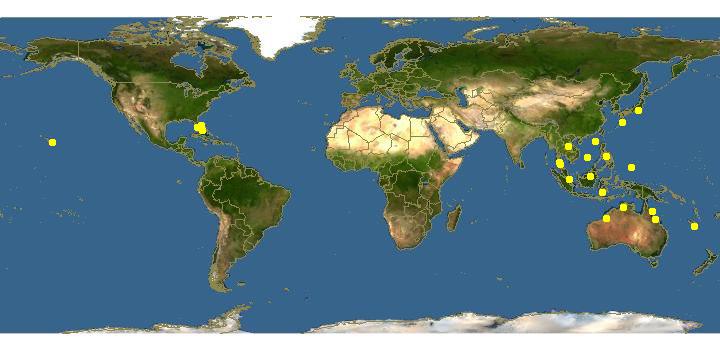http://www.fishbase.org/Summary/speciesSummary.php?genusname=Chromileptes&speciesname=altivelis ---> http://192.134.151.83/Summary/speciesSummary.php?genusname=Chromileptes&speciesname=altivelis
http://192.134.151.83/Summary/speciesSummary.php?genusname=Chromileptes&speciesname=altivelis ---> https://fishbase.mnhn.fr/Summary/speciesSummary.php?genusname=Chromileptes&speciesname=altivelis
https://fishbase.mnhn.fr/Summary/speciesSummary.php?genusname=Chromileptes&speciesname=altivelis ---> https://fishbase.mnhn.fr/summary/Chromileptes-altivelis.html
Chromileptes altivelis, Humpback grouper : fisheries, aquaculture, aquarium

You can
sponsor
this page
Common name (e.g. trout)
Genus + Species (e.g. Gadus morhua)
-

-
About this page
-
Languages
-
User feedbacks
-
Citation
-
Uploads
-
Related species
-


 Humpback grouper
Upload your
photos
and
videos
Humpback grouper
Upload your
photos
and
videos
Pictures
|
Videos |
Stamps, Coins Misc.
|
Google image
 Chromileptes altivelis
Chromileptes altivelis
Picture by
Muséum-Aquarium de Nancy/B. Alenda
Teleostei (teleosts) >
Perciformes/Serranoidei
(Groupers) >
Epinephelidae
(Groupers)
Etymology:
Chromileptes:
Greek, chromis = a fish, perhaps a perch + Greek, leptos = thin (Ref.
45335
)
.
More on author:
Valenciennes
.
Issue
The spelling of the genus is
C*h*romileptes
in Eschmeyer (CofF ver. Mar. 2011: Ref.
86697
). Although it is a logical change, it needs further inverstigations because of the general usage of
C**romileptes
.
Environment: milieu / climate zone / depth range / distribution range
Ecology
Marine; reef-associated; depth range 2 - 40 m (Ref.
9710
), usually 5 - 25 m (Ref.
90102
). Tropical; 32°N - 23°S, 88°E - 170°E (Ref.
5222
)
Western Pacific: southern Japan to Palau, Guam, New Caledonia and southern Queensland, Australia. Eastern Indian Ocean: Nicobar Islands to Broome, Western Australia. Reports from western Indian Ocean (Heemstra and Randall 1984, 1986, Ref. 3153 and 4319 respectively) are unsubstantiated, except one from Kenya (Smith 1954, Ref. 6514) which seems valid. Records from Hawaii are probably based on released aquarium fishes (Ref.
4787
).
Length at first maturity / Size / Weight / Age
Maturity: L
m
?
, range 39 - ? cm
Max length : 70.0 cm TL male/unsexed; (Ref.
5222
)
Dorsal
spines
(total): 10;
Dorsal
soft rays
(total): 17-19;
Anal
spines
: 3;
Anal
soft rays
: 9 - 10. This species is easily distinguished by its extreme smallness of size of the anterior part of the head as compared to the elevated postorbital part; absence of canine teeth, except for a very small pair at the front of the upper jaw; D X, 17-19; A III, 10 (rarely 9); a slit-like posterior nostril; color greenish white to light greenish brown with scattered round black spots on head, body, and fins, with body spots generally larger than those on head and fins; about 9 large roundish dusky blotches may be present on body, with some extending partly into base of dorsal and anal fins (Ref.
5222
); characterized further by having moderately deep body, greatest depth 2.5-3.0 in SL; small eyes; concave dorsal profile of head; rounded caudal fin (Ref.
90102
).
Generally inhabit lagoon and seaward reefs and are typically found in dead or silty areas (Ref.
9710
). Also found around coral reefs and in tide pools. Growth is very slow. Feed on small fishes and crustaceans (Ref.
37816
). Artificial spawning was accomplished in the work of Tang et al. 1979 (Ref.
6568
) where buoyant eggs measured 0.80-0.83 mm in diameter with a single oil droplet. Larvae died 7 days after hatching. Juveniles are commonly caught for the aquarium trade while adults are utilized as food fish (Ref.
9710
). Sold in Hong Kong live fish markets (Ref.
27253
).
Life cycle and mating behavior
Maturity
|
Reproduction
|
Spawning
|
Eggs
|
Fecundity
|
Larvae
Heemstra, P.C. and J.E. Randall
, 1993. FAO Species Catalogue. Vol. 16. Groupers of the world (family Serranidae, subfamily Epinephelinae). An annotated and illustrated catalogue of the grouper, rockcod, hind, coral grouper and lyretail species known to date. Rome: FAO. FAO Fish. Synop. 125(16):382 p. (Ref.
5222
)
IUCN Red List Status (Ref.
130435
)
Data deficient (DD)
; Date assessed:
20 November 2016
CITES
Not Evaluated
Not Evaluated
Threat to humans
Harmless
Human uses
Fisheries: commercial; aquaculture: commercial; aquarium: commercial
FAO - Aquaculture:
production
; Fisheries:
landings
; Publication:
search
|
FishSource
|
Sea Around Us
More information
Countries
FAO areas
Ecosystems
Occurrences
Introductions
Stocks
Ecology
Diet
Food items
Food consumption
Ration
Common names
Synonyms
Metabolism
Predators
Ecotoxicology
Reproduction
Maturity
Spawning
Spawning aggregation
Fecundity
Eggs
Egg development
Age/Size
Growth
Length-weight
Length-length
Length-frequencies
Morphometrics
Morphology
Larvae
Larval dynamics
Recruitment
Abundance
BRUVS
References
Aquaculture
Aquaculture profile
Strains
Genetics
Electrophoreses
Heritability
Diseases
Processing
Nutrients
Mass conversion
Collaborators
Pictures
Stamps, Coins Misc.
Sounds
Ciguatera
Speed
Swim. type
Gill area
Otoliths
Brains
Vision
Tools
Bio-Quiz
|
E-book
|
Field guide
|
Identification keys
|
Length-frequency wizard
|
Life-history tool
|
Point map
|
Classification Tree
|
Catch-MSY
|
Special reports
Check for Aquarium maintenance
|
Check for Species Fact Sheets
|
Check for Aquaculture Fact Sheets
Download XML
Summary page
|
Point data
|
Common names
|
Photos
Internet sources
AFORO (otoliths)
|
Alien/Invasive Species database
|
Aquatic Commons
|
BHL
|
Cloffa
|
BOLDSystems
|
Websites from users
|
Check FishWatcher
|
CISTI
|
Catalog of Fishes
:
genus
,
species
|
DiscoverLife
|
ECOTOX
| FAO - Aquaculture:
production
; Fisheries:
landings
; Publication:
search
|
Faunafri
|
Fishipedia
|
Fishtrace
| GenBank:
genome
,
nucleotide
|
GloBI
|
Google Books
|
Google Scholar
|
Google
| IGFA World Record |
MitoFish
|
National databases
|
Otolith Atlas of Taiwan Fishes
|
Public aquariums
|
PubMed
|
Reef Life Survey
| Socotra Atlas |
Tree of Life
| Wikipedia:
Go
,
Search
| World Records Freshwater Fishing |
Zoological Record
Estimates based on models
Preferred temperature (Ref.
123201
): 25 - 29, mean 28 °C (based on 702 cells).
Phylogenetic diversity index (Ref.
82804
): PD
50
= 1.0000 [Uniqueness, from 0.5 = low to 2.0 = high].
Bayesian length-weight: a=0.01349 (0.00676 - 0.02691), b=3.12 (2.94 - 3.30), in cm total length, based on LWR estimates for this species & (Sub)family-body (Ref.
93245
).
Trophic level (Ref.
69278
): 4.5 ±0.80 se; based on food items.
Generation time: 3.7 ( na - na) years. Estimated as median ln(3)/K based on 2
growth studies.
Resilience (Ref.
120179
): Medium, minimum population doubling time 1.4 - 4.4 years (Preliminary K or Fecundity.).
Fishing Vulnerability (Ref.
59153
): Low to moderate vulnerability (34 of 100).
Price category (Ref.
80766
):
Very high
.
Nutrients (Ref.
124155
): Calcium = 29.8 [16.1, 56.4] mg/100g; Iron = 0.524 [0.280, 0.985] mg/100g; Protein = 18.5 [16.5, 20.3] %; Omega3 = 0.113 [0.066, 0.190] g/100g; Selenium = 36.5 [18.6, 74.0] μg/100g; VitaminA = 66 [18, 285] μg/100g; Zinc = 0.633 [0.403, 0.990] mg/100g (wet weight);
Back to Search
Random Species
Back to Top
Accessed through:
Not available
FishBase mirror site :
localhost
Page last modified by :
mrius-barile
- 20 July 2016
Fatal error
: Uncaught ArgumentCountError: Too few arguments to function checkEcotox(), 1 passed in /var/www/html/summary/speciessummary.php on line 2304 and exactly 3 expected in /var/www/html/includes/speciessummary.lib.php:2579 Stack trace: #0 /var/www/html/summary/speciessummary.php(2304): checkEcotox() #1 {main} thrown in
/var/www/html/includes/speciessummary.lib.php
on line
2579
|





